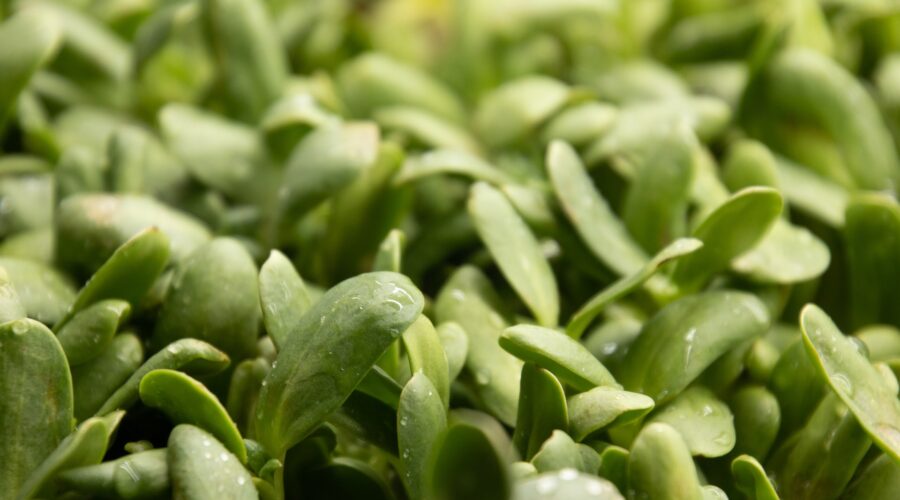These small plants are usually mistaken for sprouts or given other names such as green herbs, micro plants or micro vegetables. They have gained popularity in many restaurants, where they are used as decoration for different dishes, however, if you want to do it right, it is best to go beyond decoration.
What are microgreens and what are they not?
Depending on the species, microgreens grow 2.5-10 centimeters after 11-20 days. During that time, they have developed stems and their first leaves, meaning they are in their early stages of growth — in between sprouts and baby plants.
Microgreens do not require as much hydration and are harvested after germination, so they are more mature than sprouts, which do not yet have leaves and their flavor is less concentrated.

What do the studies say?
Microgreens are much more beneficial, as their leaves concentrate nutrients, minerals and phytonutrients. These micro plants contain a more significant number of vitamins and carotenoids, compared to mature plants, according to a study published in the Journal of Agricultural and Food Chemistry (2012).
“Although small in size, microgreens can provide surprisingly intense flavors, vivid colors, and crisp textures,” says the report, “and can be served as an edible garnish or a new salad ingredient.”
They gathered the data by studying 25 varieties of microgreens available in commercial food stores.
“Among the 25 microgreens assayed, red cabbage, cilantro, garnet amaranth, and green daikon radish had the highest concentrations of ascorbic acids, carotenoids, phylloquinone, and tocopherols, respectively. In comparison with nutritional concentrations in mature leaves (USDA National Nutrient Database), the microgreen cotyledon leaves possessed higher nutritional densities,” adds the publication.
How are microgreens used?
Their delicate appearance has made them well known as a decorative element; however, this product can also be used to add flavor to other dishes, in addition to their work as a garnish.
With a little creativity, you will never be short of dishes where you can add microgreens: salads, sandwiches, omelets, fruit smoothies, hamburgers, soups, pizza, toast and much more. Although, according to experts, the best way to eat them is fresh, right after cutting them.
In addition to their culinary applications, microgreens are a trend as a home decor piece, which means that besides your indoor plants, you can place some pots with these tiny plants and decorate your spaces with a natural, green and minimalist look.
The most common varieties of microgreens include basil, broccoli, beets, cilantro, peas, arugula, cauliflower, mustard, radish, spinach, parsley, cabbage, onion, celery and white radish.
Why eat microgreens?
Microgreens have high nutritional value — they are rich in magnesium, potassium, zinc, iron, fiber, chlorophyll, probiotics, vitamin C, E and K and more. Moreover, they produce a satiating effect and taste great. Incorporating them into your diet can improve your physical well-being.
Due to the nutritional concentration, consuming these foods could help reduce the risk of diseases such as Alzheimer’s, diabetes, dementia, cancer and heart disease. Studies have shown that increased consumption of fruits and vegetables contributes to better health.
Microgreens are easy to find, but you can easily home-grow them as well. They take up little space and only need a certain amount of sun, so they can be placed indoors or outdoors. Although it is recommended to keep them indoors for greater control and to obtain a consistent harvest.
However, if you are thinking of growing them at home, consider the quality of the seed and the growing conditions to avoid contamination with bacteria such as E. coli and salmonella.
The best choice in extreme circumstances
Some consider microgreens as the food of the future, due to their high nutritional value and low time and effort involved to cultivate them. NASA conducted studies to cover the nutritional needs of their astronauts with these microgreens, due to the ease of growing them in a few weeks, compared to the time it takes to grow mature vegetables.
“For long-duration spaceflight missions, providing adequate nutritional needs of the crew is a documented risk. This can be mitigated with dietary supplementation of nutrient-dense young vegetables including microgreens,” says the publication. “Developing microgreens for spaceflight will give us access to crops that are specifically designed to meet crew nutritional needs for future exploration missions.”
Images: Artelle Creative and Petr Magera

